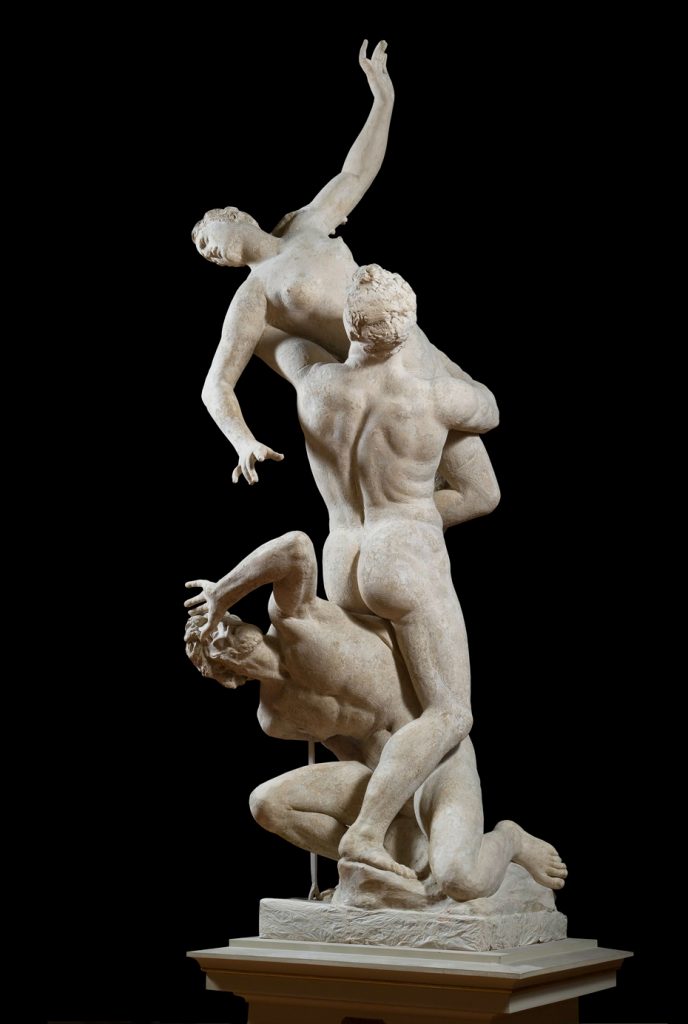The Galleria dell’Accademia is one of Florence’s most famous museums. If you’re looking to immerse yourself in the medieval and Renaissance Florentine eras, where countless iconic works of art were created, the Accademia Gallery is a must-visit. It’s a key destination for anyone looking to explore the cultural and artistic history of Florence. Inside, you’ll find masterpieces that are sure to captivate both art lovers and curious visitors alike.
Michelangelo Buonarroti: David, 1501- 1504
Michelangelo’s David is without doubt the most famous work of art in the museum; thousands of visitors arrive here to marvel at this masterpiece. This enormous piece of precisely carved marble truly comes to life as we wander around it. The proportions of the human body, the detailed muscles and even the intense gaze makes you believe that the statue could possibly move at any moment. The sculpture is truly a master’s work, made by the recognized artist Michelangelo Buonarroti.
Capturing David has been a long-loved topic in the Republic of Florence, since it represented the power and triumph of a small, determined hero over the giant Goliat; an allegory to the city’s own struggle for independence. Michelangelo reinterpreted the story, here the biblical hero is appearing before the battle with Goliat.
One of the first things that catches the eye when entering the Tribune of David is the size, a 5,17-meter-tall sculpture looks down at us. The block of marble had been long standing in the Piazza del Duomo uncarved, when in 1501, the only 26 years old Michelangelo – arriving back from Rome for this reason – started to work on it. Originally, they planned to place it on the roof of the Duomo, this is one of the reasons why the hands and head are so huge. Upon completion in 1504, it was decided that the statue was too remarkable to be placed on the roof, and it found its home in Piazza della Signoria, where a replica stands today.
This piece is truly unique, full of history, power and emotion, if you are planning to visit Florence make sure you don’t miss out on this outstanding experience.
Michelangelo Buonarroti: The Slaves, 1525-1530
While every visitor is eager to see David, there are plenty of other masterpieces in the museum worth discovering. For instance, we can explore more of Michelangelo’s later work, including his captivating sculptures of The Slaves. There are four unfinished works of the artist, – the Bearded Slave, the Young Slave, the Atlantean Slave and the Awakening Slave, – each depicting a different figure, originally intended to decorate the tomb of Pope Julius II.
These unfinished nature of the works – whether they are left this way deliberately or unintentionally – offers insight into how the artist worked, which in Michelangelo’s case is especially stunning. He believed that masterpieces were hidden within the marble itself, waiting to be revealed. Unlike many other sculptors, he didn’t rely on plaster cast models and mostly worked freehand to bring his vision to life.
As you stand in front of these unique figures you can feel the sculptures trying to liberate themselves from the heavy marble around. Don’t miss the chance to gaze at this masterpiece from close and discover the amazing details of them.
Lorenzo Bartolini: La Gipsoteca
While Michelangelo was talented enough to carve his figures without a plaster cast reference, most of the best sculptors used them. The Accademia Gallery reopened a room in 2022 dedicated to the plaster casts that served as base to the marble sculptures.
The room is filled with a stunning array of plaster casts that immediately captivate visitors. The intricate details—like tiny dots, cracks, and natural imperfections—add authenticity, while the informative videos detailing the sculpting process provide valuable insights and enrich the experience.
A room like this was a key characteristic of the most prominent 19th-century art academies. Here you can immerse in the experience, while discovering famous artists, such as the 19th century Italian sculptor Lorenzo Bartolini.
Giambologna: Rape of the Sabines 1582
When it comes to plaster casts we cannot miss out on the huge and captivating Rape of the Sabine Women by the flemish artist Giambologna. This more than 4-meter huge sculpture entwins three different figures and depicts an intense scene from the legendary history of Rome. The original marble sculpture is on Piazza della Signoria under the Loggia dei Lanzi.
The placements and the composition of the piece refer to Michelangelo and the subsequent mannerist era, where twisting and intertwining bodies were often displayed. In this work, three figures are united by a flowing, serpentine movement: a terrified Sabine woman, an enraged Roman man, and another, partially beaten man, struggling to protect the woman in distress. This dramatic interplay of intertwined bodies conveys a powerful emotional tension and complexity, a sensation that is most fully experienced when standing before the sculpture.
Filippino Lippi, Pietro Perugino: Descent from the Cross, c 1504-1507
The Accademia Gallery is full of unique sculptures, but this doesn’t mean that there aren’t any paintings worth mentioning. In the first room we can see paintings by excellent artists, such as Botticelli, Filippino Lippi and Pietro Perugino.
This piece was originally commissioned for the high altar of the Church of Santissima Annunziata in Florence, and features two panels, each adorned with vibrant, meticulously painted figures. Lippi completed the figure of Christ in 1504, just before his death. The painting was later finished by Pietro Perugino in 1507.
The Galleria dell ‘Accademia offers an unforgettable journey through Florence’s rich artistic history. Don’t miss the chance to witness the power and beauty of these timeless works in person!







Recent Comments